How to Use Competitor Keyword Data to Refine Your Strategy
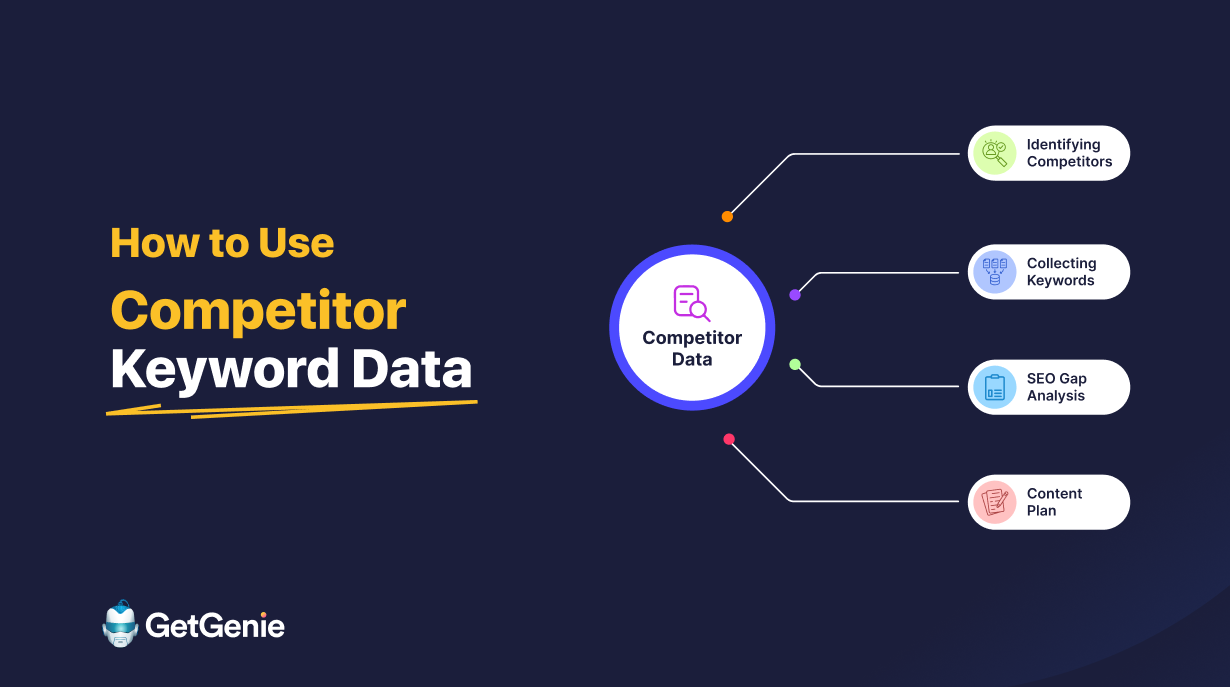
Veloce panoramica
To use competitor keyword data for improved SEO strategies that help outrank competitors:
1. Identify your true SEO competitors from the SERP,
2. Get their ranking keywords, headings, and content styles with the right tools;
3. Run a gap analysis to find keywords you don’t cover,
4. Reverse-engineer top pages with a quick content audit
5. Revise Keyword Strategy & Content Plan that aligns with your findings
Tools to Use: GetGenie, Semrush, Ahrefs, Ubbersuggest, Screaming Frog, and other SEO Tools
Have you ever wondered why as content marketers we struggle to consistently outrank competitors on Google and be at the top of the SERP? And what makes us fall behind the SERP race when we put so much effort into creating content? The answer lies in competitor keyword data.
In this blog post, I’ll help you learn the ways and tools to extract competitor keyword data to refine your SEO strategy. You’ll learn what competitor keyword analysis is, why it’s important, how it helps your content and SEO strategy, and a step-by-step process. Let’s find out how.
What Is Competitor Keyword Analysis?
Simply put, it is the process of identifying the keywords your competitors are targeting or ranking for, and using that insight to improve your own SEO and Content strategy. The analysis shows keywords your competitors rank for that you don’t, indicating gaps in the content and SEO strategy.
With tools like Ottieni Genie, Semrush, Ahrefs, Moz, and other SEO tools, you can easily and efficiently perform competitor keyword analysis.
Direct vs. indirect SEO competitors
Your direct competitors are the industry players who sell the same product or service as you do. And usually for the same audience. If you are a marketing agency serving clients through digital advertising services, your direct competitor will do the same.
However, when it comes down to ranking on the SERPs, not all competitors offer the same products as you do. For example, your marketing agency might create blog posts based on AI products. However, so can a tech magazine or business portal brand like WIRED O Forbes.
In such cases, the blog posts or articles they publish on the web, based on topics that your agency also writes on, are your REAL competitors.
Where competitor keyword data fits into your overall SEO strategy
Analyzing competitor data shows you what’s working for your competition and how you can win on the SERP. You’ll see which content types are most effective, where competitors are getting valuable backlinks, and find new, profitable keywords they’ve missed.
This analysis helps you focus on what matters most. You can find low competition keywords with high user intent. These keywords give a real chance of outranking more dominant sites. Eventually, you can set smarter goals and invest your efforts with better ROIs and results.
How to Use Competitor Keyword Data?
Identify Your True SEO Competitors
As mentioned earlier, your SEO competitors may not always be the same as your direct business competitors. For example, if you sell board games online, your business rivals might be other game retailers, but in Google results, you could also be competing against blog articles like “Top 10 Classic Board Games” written by Forbes.
Make a list of the top websites that appear for the main topics/queries in your niche. You can do this manually by searching for your keywords and noting the top results. Using SEO tools like Ottieni Genie, Ubbersuggest, or Semrush for quicker and more comprehensive results will also help.
If you use GetGenie, a content and SEO tool, it will help you identify the top pages ranking for your target keyword. You will need to type in the target keyword, select the language, and choose the region. And then click on Analyze Keyword.
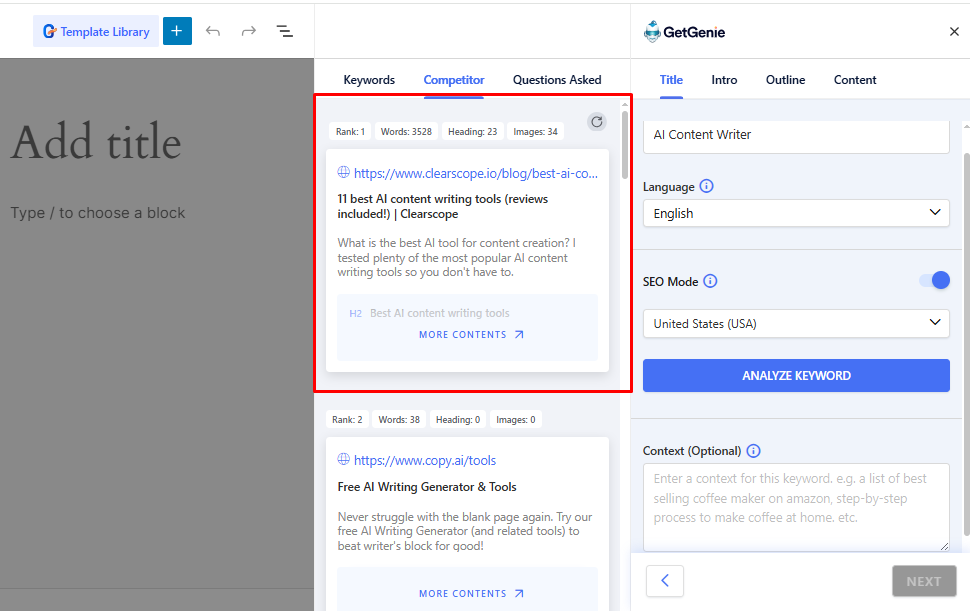
It will also show you the search volume, search trends, and competition difficulty for your target keyword.
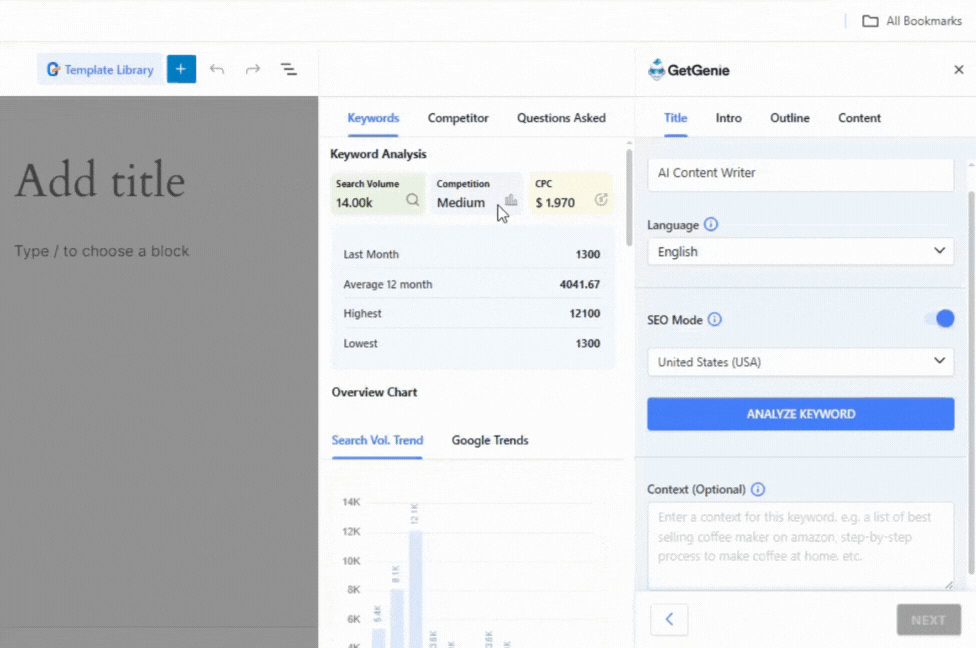
Collect Competitor Keywords
Once you know who your competitors are, it’s time to spy on their keywords. There are many keyword research tools to help with this. For instance, Semrush allows you to plug in a competitor’s URL and see all the organic keywords they rank for with a dedicated Strumento gap di parole chiave to compare multiple competitors’ keywords side by side.
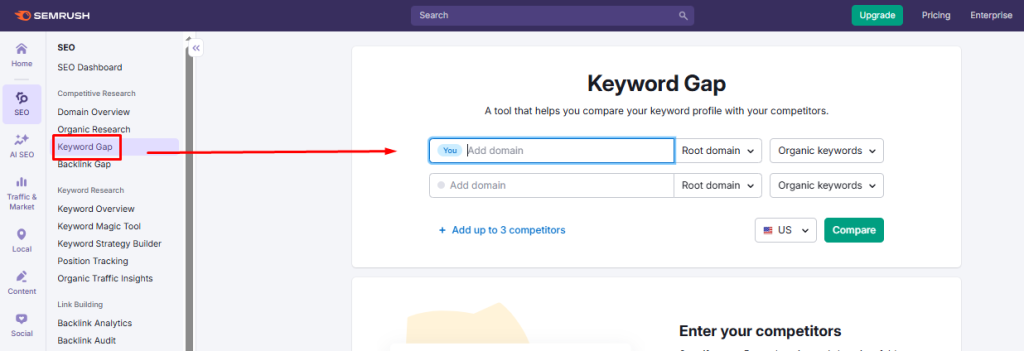
As shown above, you can use GetGenie to find related keywords of your target keyword(s), derived from SEO competitors’ content pieces (landing pages, blog posts, product descriptions, etc). Other options include SpyFu, Ubersuggest, BuzzSumo, etc.
Run a Content Gap Analysis
With keyword data in hand, the next step is to pinpoint the gaps. Keywords your competitors rank for that your site doesn’t. This is called a analisi delle lacune dei contenuti or SEO gap analysis.
Using a tool like Ahrefs with a “Content Gap” feature, you can input competitor domains, and it shows keywords they rank for that you don’t. The content gap tool will show you a list of keywords your competitors are ranking for, but you are not.
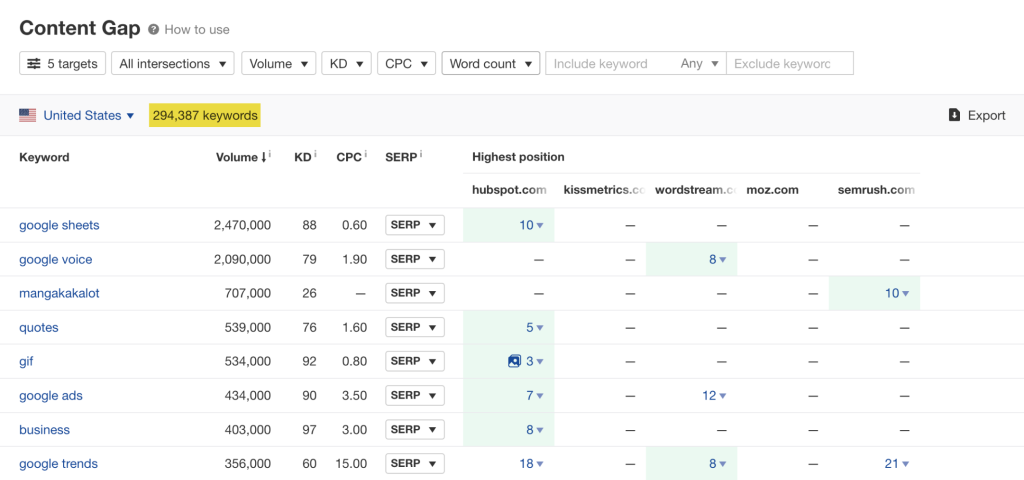
These gap keywords are high-priority opportunities to expand your content. However, not every gap is worth closing. Consider factors like search volume, keyword difficulty, and relevance to your business or the purpose of publishing.
If a competitor ranks for a very broad term that has tons of searches but extremely high competition, it might not be realistic to tackle that immediately. Focus on targeting long-tail keywords with moderate volume but low competition which give you a fighting chance to create great content and rank.
Perform a Competitor Content Audit
You need to understand how keywords are used in content. This is where you conduct a full competitor content audit. Go through some of the top-ranking pages from your competitors, especially for the high-value keywords you identified.
Then, examine aspects like:
- How long is their content?
- How is it structured (headings and subheadings)?
- What subtopics do they cover?
- Do they include images, videos, or infographics?
- How frequently do they use the target keyword and related terms?
These essentially give you a measure of why the competitor’s page might be performing well.
Identify the strengths and weaknesses of the pages/content. If you notice a competitor’s article covers a topic in a brief section, but not in depth, you can provide a more comprehensive take on it.
You can use GetGenie’s Analizzatore SERP feature to find this information or details. And improve your own content strategy by analyzing and learning from the competitors’ gaps.
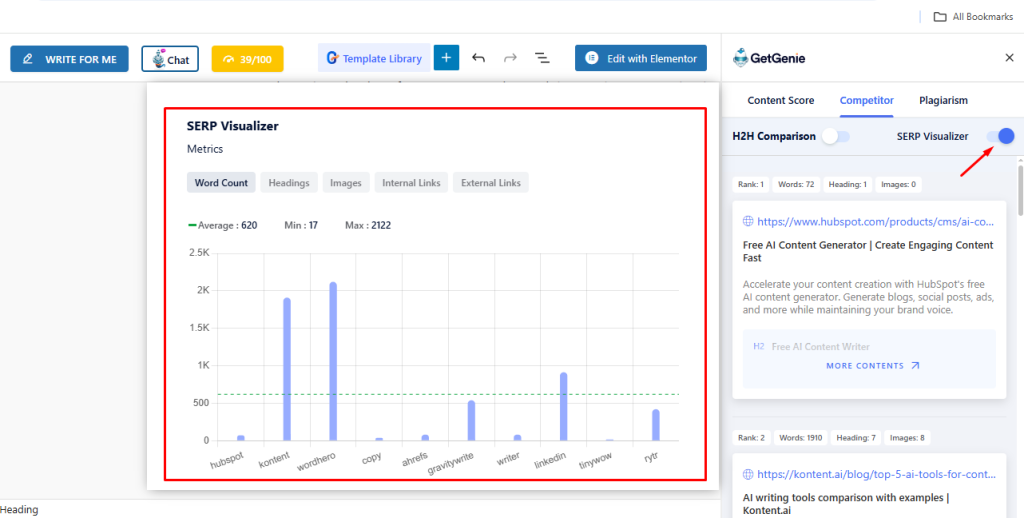
Using advanced tools like Semrush, you can perform Backlink audits, too. Though you need a paid version for it.

Improve Keyword Strategy & Content Plan
With the insights from the previous steps, you can now refine your SEO strategy. This means deciding which keywords to target and how to approach them in your content.
Start by integrating the new keywords (from your gap list) into your content calendar or SEO plan. For each keyword or topic cluster, determine whether it warrants a new piece of content or an update to existing content.
The following table will guide you on how to apply some effective strategies derived from competitor analysis to improve your SEO. It shows what actions to take when your website or content is trailing behind, at the top of the SERP, or in a so-so situation, to sustain for long:
| Sample Action Plan for SEO Ranking Scenarios | ||||
|---|---|---|---|---|
| Parola chiave | Your Domain Rank | Competitor 1 Rank | Competitor 2 Rank | Action To Take |
| “AI tool” | 15 | 8 | 12 | Migliorare: A domain ranks for a term but is outranked by competitors. The goal is to improve the position. |
| “AI automation” | Not Found | 4 | 7 | Grow: A competitor ranks for a term, but a domain does not. This is a keyword gap to pursue. |
| “AI Engineering” | Not Found | Not Found | 16 | Grow: A competitor ranks for a term, but a domain does not. This is a keyword gap to pursue. |
| “AI writing” | 1 | 3 | 5 | Defend: A domain ranks better than its competitors. The goal is to maintain this position. |
| “AI SEO” | 9 | 14 | 1 | Improve/Defend: The domain outranks one competitor but is outranked by another. |
Then, work on the following:
New Content to Fill Gaps:
For important content gaps, plan to create high-quality content centered on those keywords. Put extra focus on topics that many competitors rank for, showing strong user interest.
By producing content for these terms, you close the gap and can capture that traffic. Also, ensure your new content is better than what’s out there, offers more value, up-to-date information, a clearer structure, and/or a unique perspective.
👉 Strategies to Rank High on the SERP
Improve Existing Content for Competitive Keywords:
Next, look at keywords you are already targeting where competitors still outperform you. Then, add missing subtopics that top-ranking pages cover. Also, update any outdated information.
You must also improve your on-page SEO by ensuring the keyword and variants appear in headings, and that your meta tags are compelling.
👉 Learn How to Optimize Existing Content Efficiently
Optimize for SERP Features:
Competitor keyword data can also show where competitors get featured snippets, “People Also Ask” results, or other SERP features. If you notice a competitor consistently showing up in a featured snippet for a query, analyze how they structured their answer.
Perhaps they used a bullet list or a concise definition. You can edit your content to try and grab that snippet position by providing an even clearer, well-formatted answer.
👉 Get Noticed In People Also Ask Like a Pro
Use Keyword Data for Intent of Content:
The insights you’ve gained should influence your keyword strategy going forward. You may find that competitors are focusing on informational content around your product niche, indicating you should beef up your blog and not just product pages.
Use the data to adjust your content mix, site structure, intent, and even product/service positioning if needed.
👉 Improve Content Strategy with NLP
Monitor and Adjust:
Refining your strategy is an ongoing process. SEO is dynamic; competitors will continue to publish and update content, and new players can enter the scene. Make competitor keyword analysis a regular part of your SEO audit routine.
Experts suggest doing a comprehensive competitor keyword review roughly once per quarter in most cases. However, if you analyze too frequently, you might chase every minor change and lose focus. Find a balance that keeps you informed but leaves time for your changes to take effect.
👉 Fix SEO Issues with Ease with the Right Techniques
Measuring Results
Ultimately, you would want positive business results from competitor keyword analysis for your SEO strategy. The data collected provides a basis for setting Key Performance Indicators (KPIs) to track progress against a newly created strategy.
Key metrics to monitor include:
- New keyword rankings in the top 10-20 entries on Google.
- Growth in organic traffic to pages that target new keywords.
- An increase in leads or conversions resulting from the optimized content.
- The number of “new keywords” and “lost keywords” was tracked over time to identify shifting trends and opportunities.
Common Pitfalls to Avoid
When setting your Keyword and SEO strategy using competitor user data, you might trip into some pitfalls. Making these errors will slow down your progress or increase unwanted costs.
Copying instead of improving
The most critical error is to simply copy instead of improving a competitor’s content. Search engines do not reward duplicate content. You can only be a key player in the SERP race with unique and valuable content. That is more informative and engaging than what already exists.
Focusing only on Search Volume
If you focus on popular search terms with high search volumes, then you need to have a strong Domain Authority to stand any chance of succeeding. This is where many emerging websites fall apart and get lost in the mix.
A more effective strategy is to target relevant long-tail keywords with lower competition and higher conversion potential. Instead of competing with websites with significant domain authority.
Ignoring search intent & SERP content formats
Failing to align with the user’s “why” behind a search query will lead to high bounce rates and low engagement. His signals a negative user experience to search engines. It is best to pay attention to the content formats that already rank, such as guides, listicles, reels, or videos.
Over-auditing and losing focus
Over-auditing can also become a pitfall, as a comprehensive manual audit can take weeks to complete. The danger lies in analysis paralysis, and the solution is to use tools that simplify the process, helping you focus on the most valuable, high-ROI opportunities.
Neglecting UX, internal links, and E-E-A-T signals
You must also keep in mind technical SEO issues like a proper, friendly user interface; strategically included internal links, and EEAT principles.
Domande frequenti
How do I find out what keywords my competitors are using, fast?
Insert the URL of a rival domain into tools like Ahrefs, Semrush, or SpyFu to extract their ranking keywords; then cross-check SERPs manually. For a specific topic, you can use GetGenie’s Competitor Analysis to see which terms, headings, and entities top articles emphasize.
What’s the difference between SEO gap analysis and keyword overlap?
Gap analysis refers to keywords competitors rank for that you don’t. Which means new opportunities. On the other hand, Keyword overlap means keywords you both rank for, where you need to optimize to go ahead.
How often should I run a competitor keyword analysis?
Performing competitor analysis quarterly is a solid baseline; go monthly in fast-moving niches or after major updates/content launches.
Can I outrank big sites with a smaller domain?
Yes, target high-intent long-tail keywords, match search intent precisely, cover topics comprehensively, tighten on-page SEO/internal links, and earn credible links or E-E-A-T signals.
Are free competitor analysis tools enough to start?
Yes, for initial research and validation, you can. But they’re limited to in-depth analysis. For the most comprehensive insights, pair them with paid data and use GetGenie to turn insights into better briefs and content faster.
Riassumendo
Competitor keyword analysis is like having your competitors’ playbooks. By identifying gaps, overlaps, and opportunities, you can reverse engineer their rankings and turn insights into traffic.
With tools like GetGenie’s Competitor Analysis, you can beat them by creating smarter, better-optimized content with the help of SEO analytics and AI-powered content. So it is a must to mix the use of tools and your own analysis and get the most effectively optimized pages.

